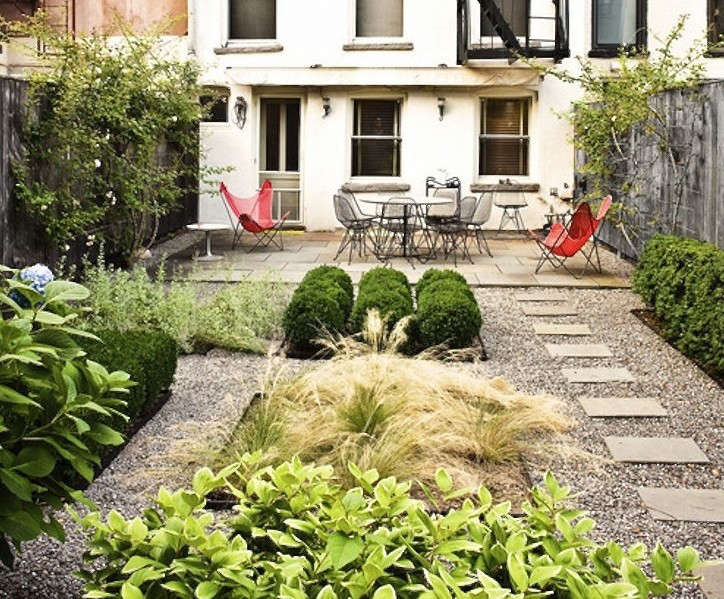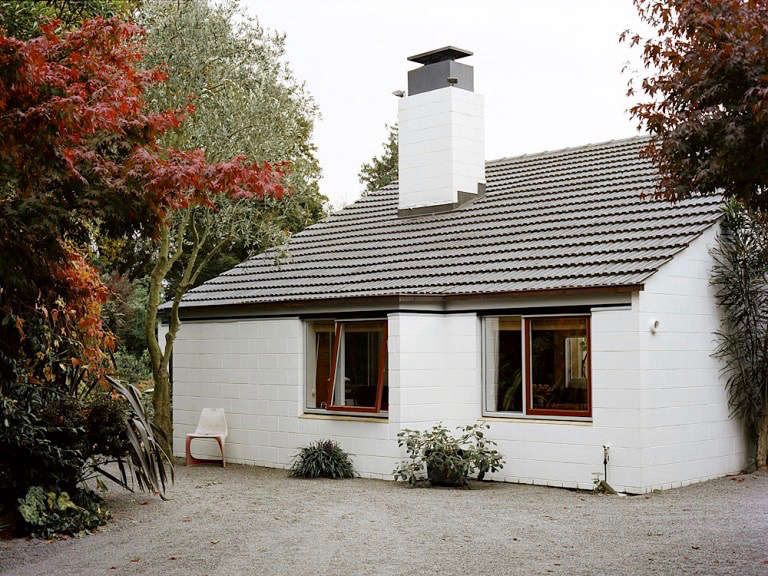“Gravel garden” sounds like an oxymoron. Why dump a load of stone in a garden instead of planting grass or installing a more permanent hardscape surface?
Three good reasons: Gravel gardens look lovely, cost little, and offer major environmental benefits.
Is a gravel garden right for you? Read on:
Above: For more of this garden, see Steal This Look: Modern Brooklyn Backyard on a Budget.
What is a gravel garden?
Big or small, a gravel garden is an area with a crushed stone surface. You can use gravel as a patio surface, on a driveway, to create paths, or to mulch around plants in beds. Gravel is a magical material, visually. It has a soft, three-dimensional surface that’s still uniform. It becomes an instant backdrop to naturally focuses attention elsewhere–on nearby plants, fences, furniture. Against gravel, everything else pops.
Above: Photograph by Mary Gaudin.
A long gravel driveway leads to Ballantyne House, a midcentury modern house in Christchurch, New Zealand designed by modernist architect Sir Miles Warren in 1959.
A gravel garden is inexpensive and easy to install compared to other more permanent hardscape surfaces. If you get sick of it, shovel up the gravel and try something else. If you decide you want to rearrange things, dig a hole in it to plant shrubs or a tree.
Gravel gardens are friendly. They don’t require water. They filter rainwater to prevent runoff. Gravel is cooler underfoot than a hard stone surface. And you don’t need to mow it, rake it (except when you’re feeling meditative), or weed it more than once every few months.
Above: The gray color of a galvanized meal stock tank complements a pea gravel patio; in contrast, green plants and water surfaces appear vibrant and bright. For more of this garden, see Garden Rehab: A Makeover for a Ranch-Style House.
What are the benefits of replacing a lawn with a gravel garden?
Turf is a water hog; lawn grass requires In hot climates such as Phoenix and Las Vegas, from 60 to 70 percent of household water is used outdoors (and turf-dominant landscapes typically use 54 percent more water than other gardens). The EPA recommends planting turf on no more than 40 percent of your landscaped property.
For every square foot of turf you replace with gravel, you can save thousands of gallons of water per year, even if you have a small lawn. For example, if you live in a semi-arid climate such as Colorado Springs and have 10,500 square feet of lawn, replacing 25 percent of the turf with a gravel garden will save up to 38,000 gallons of water per year, according to the US Department of Energy. (To calculate how much water your own lawn uses, see Guidelines for Estimating Landscaping Water Use.)
Above: Photograph by Jim Powell for Gardenista.
Surrounded by woodland, a gravel seating circle surrounds a fire pit and provides a buffer between sparks and the garden. For more of this project, see Lessons Learned: From “Neglected” Slope to Charming Garden, in South London.
How do I design a gravel garden?
Gravel is a chameleon, a hardscaping material that looks comfortable next to nearly architectural style, from chateau to contemporary. Whether you live in Provence, Los Angeles, or Tokyo, a gravel garden can look right at home.
A few design guidelines: Gravel’s job is to blend in. A gravel garden should focus attention elsewhere, on surrounding green plants or architectural elements (such as nearby pergolas, fences, or trellises). Choose a gravel color to match that doesn’t fight the colors of your house’s paint or other existing hardscape materials. Light-colored gravel looks particularly good against stucco or white-painted brick, and gray gravel is handsome against brown, black, and natural-wood colors. Pick a gravel color to blend in rather than for contrast, to create a serene backdrop.
Above: Photograph by Michelle Slatalla.
In the courtyard at Shed, the light-filled restaurant and housewares emporium housed in a 10,000-square-foot, glass-walled barn in Healdsburg, California, the flooring is a recycled plastic surface called Gravelpave, individual pavers with rings (1 inch deep and 2 inches in diameter) designed to be filled with gravel. For more of this project, see Steal This Look: Garden Courtyard at Shed in Healdsburg, CA.
How do you install a gravel garden?
Compared to other kinds of hardscape materials, gravel is easy to work and forgiving to work with. The most challenging part of installing a gravel garden, in fact, is to get rid of the old surface. If you’re replacing a concrete patio, for instance, you will have to demolish it (with a sledgehammer or jackhammer) and cart away the debris. If you want to replace turf, you need to dig up the grass–and roots–and send it to the compost bin.
After a surface is clear, tamp it down or compact it with a roller (there’s no need to level it as precisely as you would before laying a solid hardscape material such as brick or stone). Lay a layer of base rock and then add a 3-inch layer of gravel. Rake the surface smooth.
Above: A metal urn, bluestone steps, and crushed gravel create a harmonious backdrop for shrubbery. Photograph by Matthew Williams for Gardenista.
What is the best kind of gravel to use?
The most important consideration is the size of the stone. For a patio, path, driveway, or other high-traffic zone, use gravel that is no bigger than â…œ inch, because a smaller size is more stable. The finer the gravel, the better it will feel underfoot; in an area where you expect bare feet, use ¼-inch gravel.
Above: In Alamo, California Kriste Michelini and Esther Arnold created a vegetable garden set against a backdrop of decomposed granite, which prevents runoff and filters rainwater into the earth. See more in Gardenista Considered Design Awards 2014: Finalists for Best Edible Garden.
How much does it cost to install a gravel garden?
A gravel surface, including a layer of base rock, costs about $5 per square foot to install, an inexpensive choice compared to brick, wood, or solid stone slabs. A bluestone patio, for instance, can cost from $16 to $26 per square foot to install.
Above: A bed of gravel anchors the furnishings to create an ad hoc patio. Photograph by Nicole Franzen for Gardenista..
Pros
- Saves water.
- Inexpensive to install.
- Versatile material that blends well with other hardscape.
- Low-maintenance; rake it smooth from time to time.
- Permeable to prevent runoff.
- Crunchy sound underfoot.
Cons
- Can be difficult to shovel in snowy climates.
- Does not provide a solid base for dining furniture.
- Needs to be replenished every four years or so.
For more ideas for using gravel in a garden, see:
- Low-Cost Luxe: 9 Pea Gravel Patio Ideas to Steal.
- Garden Envy: 10 Dramatic Drainage Ideas.
- Expert Advice: 11 Tips for Gravel Garden Design.
Finally, learn how to successfully use gravel in a hardscape project with our Hardscaping 101: Gravel guide.
N.B.: This is an update of a post originally published September 24, 2015.





















Have a Question or Comment About This Post?
Join the conversation (0)